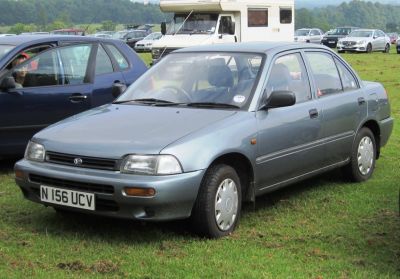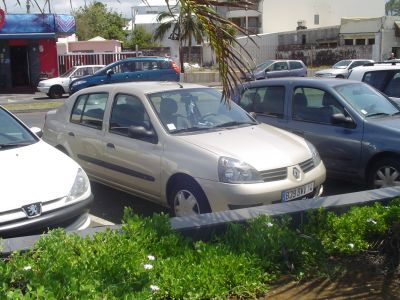 1994 Maruti Esteem Dimensions, Size & Specs
1994 Maruti Esteem Dimensions, Size & Specs
Measurements of the 1994 Maruti Esteem, engineered for optimal performance and comfort
| Dimensions | |
|---|---|
| Length: | 4075-4090 mm160.4-161.0 in13.4-13.4 ft |
| Width: | 1575 mm62.0 in5.2 ft |
| Height: | 1395 mm54.9 in4.6 ft |
| Trunk Capacity: | 365 liter12.9 cu ft |
| Weight Specifications | |
| Curb Weight: | 870-1260 kg1918-2778 lbs |
| Maximal permitted Weight: | 1315-1375 kg2899-3031 lbs |
| Tire Specifications | |
| Rims Size: |
|
| Tire Sizes: |
|
The Maruti Esteem, produced from 1995 to 2004, is a compact sedan that marked a significant presence in the mid-1990s Indian automobile market. Measuring between 4075 mm and 4090 mm (approximately 160.4 to 161 inches) in length, it offered a balanced size suitable for urban maneuverability combined with enough interior space for comfort. With a width of 1575 mm (62 inches) and a height of 1395 mm (55 inches), the Esteem's compact footprint made it a practical choice for city driving.
This sedan's curb weight ranged from 870 kg to 1260 kg (1918 to 2778 pounds), depending on the variant and specifications, while the maximum permissible weight was between 1315 kg and 1375 kg (2898 to 3032 pounds). These weight variations influenced fuel efficiency and handling characteristics, making the Esteem adaptable for both fuel-conscious drivers and those needing a slightly more robust build.
Luggage capacity stood at a decent 365 liters (12.9 cubic feet), offering ample space for day-to-day needs or weekend trips. The car was equipped with 13-inch rims and commonly paired with tire sizes such as 155/80 R13 S, 175/70 R13, and 155/65 R13, ensuring a stable ride and good road grip for a vehicle of this class.
Overall, the Maruti Esteem sedan from this era represented a reliable and economical option, combining moderate dimensions with functional capacity. It remains a reference point in compact sedan size comparisons, reflecting the design priorities and market demands of the late 1990s and early 2000s in India.
Discover the standout features that make the 1994 Maruti Esteem a leader in its class
Have a question? Please check our knowledgebase first.
The Maruti Esteem 1994 generation measures between 4075 mm to 4090 mm in length, which translates to approximately 160.4 to 161.0 inches (or about 13.37 to 13.42 feet). This relatively compact length makes it suitable for urban driving and parking, balancing interior space with maneuverability. The slight variation in length across different models or trims might be due to minor design tweaks or added features but remains within a narrow range, ensuring the car maintains a consistent footprint on the road.
The width of the 1994 Maruti Esteem is 1575 mm, equivalent to about 62.0 inches (approximately 5.17 feet). This width is quite typical for compact sedans from the mid-1990s, offering enough shoulder room for passengers while ensuring the car remains easy to navigate through narrow city streets. The moderate width plays a vital role in stability and cabin spaciousness, balancing comfort with drivability in urban and suburban environments.
The height of the 1994 Maruti Esteem stands at 1395 mm, which converts to approximately 54.9 inches (or about 4.57 feet). This height offers a balanced profile that contributes to both aerodynamic efficiency and adequate headroom inside the cabin for passengers. While not exceptionally tall, the car's stance ensures a comfortable seating position for most occupants, allowing sufficient clearance without making the sedan appear bulky or top-heavy.
The curb weight of the Maruti Esteem from this generation varies between 870 kg and 1260 kg, which is approximately 1918 to 2778 pounds. The lighter models within this range are generally the base or less equipped variants, while the upper end likely includes models with added features or more powerful engines. This weight range contributes to relatively nimble handling and reasonable acceleration for a compact sedan of its time. Additionally, a lower curb weight generally favors better fuel efficiency, which is an essential factor for cost-conscious drivers.
The maximum weight capacity (gross vehicle weight) for the 1994 Maruti Esteem ranges from 1315 kg to 1375 kg, equating to about 2899 to 3032 pounds. This capacity includes the weight of the vehicle itself, passengers, cargo, and any additional equipment. Essentially, the vehicle can safely carry around 445 to 505 kilograms (approximately 981 to 1113 pounds) of passengers and luggage combined. Understanding this limit is essential for safety and performance, ensuring the car maintains handling and braking capabilities under load.
The Maruti Esteem offers a luggage capacity of 365 liters, which is roughly 12.89 cubic feet. This capacity is quite practical for a compact sedan, providing ample space for groceries, suitcases, or everyday items. The cargo space can comfortably handle luggage for small families or passengers during city commutes and weekend trips. While it might not compare to larger sedans or SUVs, the boot size efficiently maximizes the available space without compromising passenger comfort.
Yes, the Maruti Esteem 1994 generation generally fits comfortably into a standard home garage. Typical home garages have a width of about 2.4 to 3 meters (7.9 to 9.8 feet) and a length of around 5.5 to 6 meters (18 to 20 feet). Given the Esteem’s length of approximately 4.075 to 4.09 meters (13.4 feet) and width of 1.575 meters (5.17 feet), it will leave sufficient space on all sides for easy parking and opening doors. This makes the Esteem a practical choice for owners concerned about storage convenience.
The 1994 Maruti Esteem saw modest changes in size compared to its predecessor, the Maruti Suzuki Swift-based sedan (earlier Esteem models were based on the Suzuki Swift platform). While exact predecessor dimensions can vary depending on model year, the 1994 Esteem typically grew slightly in length and maintained similar width and height, reflecting a trend toward more spacious and comfortable cabin designs without significantly increasing the car’s footprint. These dimensional changes helped improve passenger comfort and added a more modern appearance while preserving its compact nature for easy city driving.
Compared to similar compact sedans from the mid-1990s, such as the Honda City or Toyota Corolla of that era, the Maruti Esteem holds a competitive stance. With a length of about 4.07 to 4.09 meters, it is slightly shorter or on par with many competitors. Its width of 1.575 meters is modest but typical for compact sedans, while the height is on the lower side, supporting a sportier silhouette. The luggage capacity of 365 liters is comparable and, in many cases, better than rivals. Overall, the Esteem balanced compact dimensions with practical interior and cargo space, making it well-suited for urban use.
The Maruti Esteem 1994 generation comes equipped with 13-inch rims, fitted with tire sizes such as 155/80 R13 S, 175/70 R13, and 155/65 R13. These smaller diameter wheels are typical for compact sedans of the era, contributing to a comfortable ride by cushioning road imperfections and offering good grip for general driving conditions. The variation in tire widths and profiles across trims affects handling dynamics and ride quality slightly, with wider tires potentially offering better cornering stability, while narrower ones enhance fuel efficiency and ride comfort. Overall, these tire-rim configurations complement the Esteem’s balance of economy and agile driving.
Discover similar sized cars.

| Production: | 1994-2000 |
|---|---|
| Model Year: | 1994 |
| Length: | 4085 mm160.8 in |
| Width: | 1620 mm63.8 in |
| Height: | 1390 mm54.7 in |

| Production: | 1973-1979 |
|---|---|
| Model Year: | 1973 |
| Length: | 4124 mm162.4 in |
| Width: | 1580-1590 mm62.2-62.6 in |
| Height: | 1375-1385 mm54.1-54.5 in |

| Production: | 1994-2000 |
|---|---|
| Model Year: | 1994 |
| Length: | 4165 mm164.0 in |
| Width: | 1665 mm65.6 in |
| Height: | 1450 mm57.1 in |

| Production: | 2002-2008 |
|---|---|
| Model Year: | 2002 |
| Length: | 4171 mm164.2 in |
| Width: | 1639 mm64.5 in |
| Height: | 1437 mm56.6 in |

| Production: | 1990-2000 |
|---|---|
| Model Year: | 1990 |
| Length: | 4075 mm160.4 in |
| Width: | 1575 mm62.0 in |
| Height: | 1395 mm54.9 in |

| Production: | 1995-1999 |
|---|---|
| Model Year: | 1995 |
| Length: | 4117 mm162.1 in |
| Width: | 1620 mm63.8 in |
| Height: | 1394 mm54.9 in |
